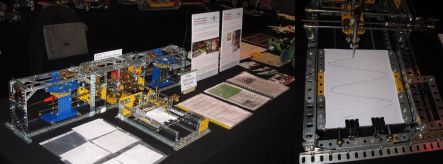Our Changing World for Thursday 9 December 2010
50 Years of Lasers
While it is widely acknowledged that the laser was invented in 1960 by Theodore Maiman, much controversy surrounds its development. It was a scientific race, with patent disputes, debates over who should win Nobel Prizes, and legal battles over the millions of dollars resulting from its invention.
The term LASER is an acronym which stands for light amplification by stimulated emission of radiation, and back in 1917, Albert Einstein predicted the physical phenomenon which was later dubbed stimulated emission. In 1954, a working maser (the microwave version of the laser) was developed by Charles Townes and his colleagues, and also independently by Nikolai Basov and Aleksandr Prokhorov. Gordon Gould coined the term laser, but his patent for the laser, filed in 1959, was denied. The first working laser (a ruby laser) was demonstrated by Theodore Maiman at Hughes Research Laboratories in 1960.
Laser light is extremely pure: it is monochromatic, coherent and directional. These properties enable a wide array of scientific work, and applications.

From left to right: Kylie Price, Justin Hodgkiss and Cather Simpson (images: John Martin, Gerry Keating, and University of Auckland)
To find out how a laser works, and to discover some of the things lasers are being used for (now and potentially in the future), Ruth Beran meets Cather Simpson from the University of Auckland, Kylie Price from the Malaghan Institute of Medical Research and Justin Hodgkiss from Victoria University.
Cather Simpson runs the Photon Factory and is using lasers to make "molecular dragons". In the same way that a dragon focuses heat, she's trying to make molecules that can focus the intermolecular flow of excess vibrational energy to generate very local changes in temperature. Kylie Price is the Hugh Green Flow Cytometry Fellow and she uses lasers to sort cells. Justin Hodgkiss is using time-resolved laser spectroscopy to make better solar cells. Listen to a previous Our Changing World story with Kylie Price here, and another with Justin Hodgkiss here.
John Field, who works at Carter Observatory by day, and is an amateur astronomer at night, also demonstrates how a laser pointer can be used to "touch" a star. Listen to a previous Our Changing World story with John Field here.
Over the past year, many Our Changing World Stories have featured lasers. Here are some of them:
Laser Scans of Moriori Dendroglyphs
Prime Minister's Future Scientist - Optical tube
Capturing and Seeing a Single Atom
Adam and Eve's Belly Buttons
During the mid-19th century, geologists were gathering evidence for the great antiquity of Earth and the discovery of fossils of extinct creatures fuelled speculations about evolution. In 1857, Philip Gosse, a naturalist and explorer but also a Biblical fundamentalist who had been agonising about the clash between science and religion, wrote a book called Omphalos (Greek for belly button). In it, he suggested that the conflict could be solved if one assumed that God had created the world as if scientific theories were true - and, among other things, had put fossils into rocks and given Adam and Eve belly buttons.
University of Otago science philosopher Alan Musgrave returns to Our Changing World to discuss theological surrealism, which follows Gosse's ideas, and secular surrealism, which postulates that phenomena simply are as if science were true.
Educated at the London School of Economics, Alan Musgrave completed his doctorate under the supervision of Sir Karl Popper, whom he acknowledges as his inspiration to focus on the philosophy of science. This conversation is based on a chapter in his latest book, Secular Sermons, published by Otago University Press, in which he explores many basic assumptions in science, religion and mathematics.
To hear earlier conversations with Alan Musgrave, go to:
Meccano

The Mini Differential Analyser (left) and at work, plotting a sine wave (right).
Contrary to popular belief, Meccano didn't disappear with the arrival of Lego and Playstation, and of late, has been enjoying an upswing in public profile. First manufactured more than a century ago, generations of engineers, designers and mechanics cut their teeth on the metal strips, plates and bolts, building trains, cranes, planes and bridges, before going on to construct the real thing. And every component part of Meccano whether it was manufactured in 1901 or just last week, are still compatible with every other part ever made.
But did you know that Meccano also has a place in New Zealand's science and engineering history, not just as a toy, but as a serious tool for plotting graphs and designing dams? At the Museum of New Zealand, Te Papa Tongarewa in Wellington, a recent exhibition by the New Zealand Federation of Meccano Modellers put that proud history on display for kids of all ages to discover.